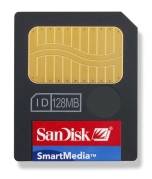History of Computers - Flash Memory
Flash memory is a type of EEPROM (Electrically Erasable Programmable Read Only Memory). It can be used to store information without requiring a source of power.
Contents
Overview
Flash memory is a type of non-volatile memory. This means that it can sustain its data without power, like a hard drive. Flash memory comes it 2 types, NOR and NAND[1]. NOR is optimized for storing things that will be executed (like programs), while NAND is optimized for data storage and is easier to make in higher capacities[1]. Flash memory in the form of USB flash drives and solid state drives has become the primary physical way to transfer information from computer to computer. Here are the most common forms of Flash Memory
| Name | Description | Picture |
|---|---|---|
| Secure Digital | A pretty small card that is commonly used in cameras and other "pocket sized" devices. It is available in various varieties (Standard SD, High Capacity SD, Mini SD, Micro SD.[2] | 
|
| Compact Flash | Relatively speaking, one of the larger of the flash memory forms. It used to be very popular, but went down for a while. It is now not very popular, but it may be making a comeback. One of its benefits is that size and number of pins allows it to act like a regular port. Many wireless cards and micro-hard drives have been made that fit in the CF slot and are compatible with devices that use CF cards.[3] | 
|
| SmartMedia | Even though SmartMedia cards are no longer produced, they were one of the thinnest flash devices ever. At less than .03" thick, they were the thickness of about 10 sheets of paper. Due in part to their thinness, their storage capacity was always low, and they were also very prone to data corruption.[3] | 
|
| Memory Stick | The Memory Stick is most commonly available in the Memory Stick Pro, MS-PRO Duo and the Memory Stick Micro (M2) forms. Its main sponsor is Sony, and most of Sony's devices use this format (Their digital cameras, PSPs, etc.) [4] | 
|
Significance
Flash memory has replaced floppy drives, and later CDs, as the main way to store information and transfer it between computers. Also, flash memory has almost entirely wiped out film in cameras. At this rate, flash memory may wipe out CDs and DVDs. Flash memory has become so ubiquitous that almost everyone has a flash drive or other type of flash memory. Also, it has become so cheap to produce small USB flash drives, that companies often give them away for free as advertising. Flash Memory can also be found in almost every electronic device, from MP3 players to cell phones to even some TVs. Flash memory has made it realistic to carry around multiple gigabytes (What would have filled up 5-10 CDs) of data in your pocket. Without flash memory, many devices would have to carry an extra back-up battery to provide power to the memory. This would have made it impossible for many of the devices we use every day to exist.
Links
References
- ↑ 1.0 1.1 http://www.dataio.com/pdf/NAND/MSystems/MSystems_NOR_vs_NAND.pdf
- ↑ http://www.sdcard.org/developers/tech/
- ↑ 3.0 3.1 http://electronics.howstuffworks.com/flash-memory.htm
- ↑ http://www.sonystyle.com/webapp/wcs/stores/servlet/ProductDisplay?catalogId=10551&storeId=10151&langId=-1&productId=11039245#features